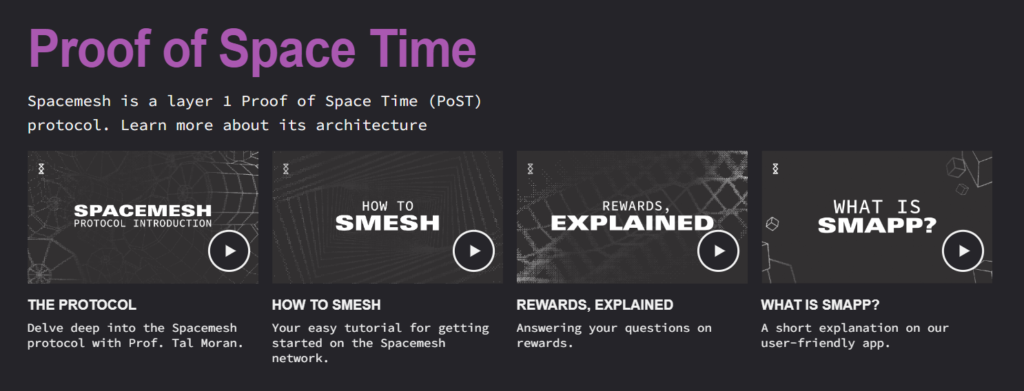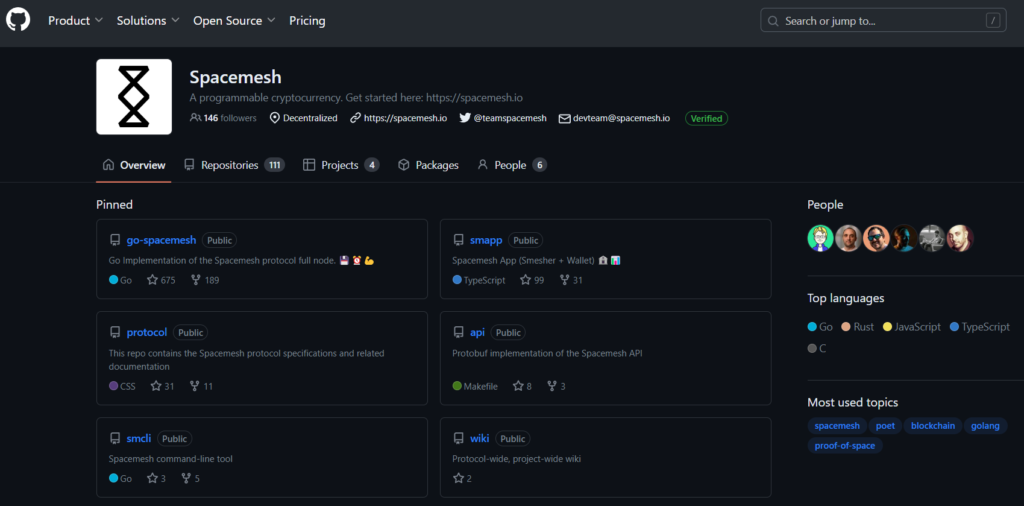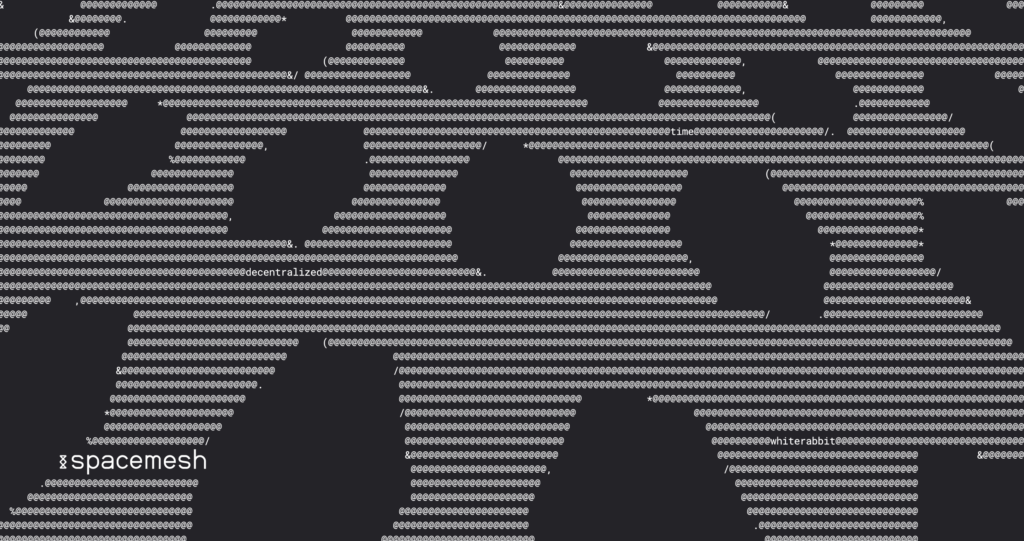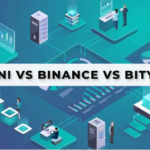
Spacemesh operates as a decentralized blockchain platform that employs an innovative consensus algorithm known as Proof of Space-Time (PoST). PoST incentivizes users for allocating storage space and time to the network instead of relying on computational power, thereby fostering equity and energy conservation. This novel approach ensures that a more extensive group of participants can actively engage in enhancing network security and reaping the associated benefits.
Table of Contents
What makes this review different?
Reviewing a crypto project as an investor is kind of like comparing how someone who’s considering buying a car feels versus someone who’s just interested in learning about cars.
- Financial Focus: Investors are like potential car buyers who are also thinking about the cost and resale value. They’re not just curious about the car’s features, but they want to know if it’s a good deal and if it will go up in value like a collector’s car.
- Safety Concerns: Investors are like people who are not only interested in a car’s design but also want to know if it’s safe to drive. They check if it has good brakes, airbags, and how it handles in different conditions. Similarly, investors assess the safety and security of a crypto project.
- Long-Term vs. Short-Term: Imagine some people look at cars as collectors’ items and want to keep them for years, while others are looking to buy a car and sell it for a profit in a few months. Similarly, investors in cryptocurrencies can have different timeframes for holding their investments.
- Choosing the Right Mix: Some people are interested in various types of cars, like SUVs for family trips and sports cars for fun. Investors often want to diversify their investments by choosing different cryptocurrencies to balance risk and potential rewards.
- Setting Goals: Imagine someone who wants a car to use for a cross-country road trip versus someone who wants a car for commuting. Investors have specific financial goals, like saving for retirement or making a quick profit, and they choose investments that align with those goals.
- Exit Plan: People who want to buy cars may also have a plan to sell them someday. Investors often have an exit strategy, meaning they decide in advance when and how they’ll sell their crypto investments to make a profit.
- Doing Homework: People who want to buy a car may research the make and model, look at reviews, and compare prices. Investors do something similar by researching crypto projects, their technology, and market trends.
- Risk Tolerance: Just like some people prefer a reliable car brand, while others like more adventurous off-road vehicles, investors have different levels of risk tolerance. Some like stable, well-established cryptocurrencies, while others are willing to take risks on newer, more volatile ones.
In simple terms, investors look at cryptocurrencies not just as cool technology but as potential ways to make money, and they do more detailed research and planning to make the right choices. However, they should also be aware that investing in cryptocurrencies can be risky, just like buying a car with the hope that it will gain value.
For those who have “NO IDEA?!” here’s some layman talk:
Okay, but what is Spacemesh, and how does it work? ????
Spacemesh is a decentralized blockchain platform that utilizes a unique consensus algorithm called Proof of Space-Time (PoST). PoST rewards participants for dedicating storage space and time to the network, rather than computational power. This approach promotes fairness and energy efficiency, making it accessible for a wider range of participants to contribute to the network’s security and earn rewards.
Also, How can I participate in Spacemesh mining?
To participate in Spacemesh mining, you need to download the Spacemesh software and allocate storage space on your computer. The software will automatically verify and reward your commitment of space and time. Detailed instructions on how to get started with Spacemesh mining can be found in the official documentation.
Hmm, but What are the benefits of the Proof of Space-Time (PoST) consensus algorithm?
PoST is designed to be energy-efficient and more accessible than traditional proof-of-work or proof-of-stake algorithms. It allows users to mine without expensive hardware or high energy consumption, promoting a more decentralized and eco-friendly network. PoST also reduces the risk of centralization associated with powerful mining pools.
Is Spacemesh secure, and has it undergone security audits?
Spacemesh takes security seriously and has implemented various measures to secure its network. The code and smart contracts have been subject to security audits by reputable third-party firms to identify and address potential vulnerabilities.
What is the roadmap for Spacemesh’s development?
Spacemesh has a well-defined roadmap that outlines its development phases and goals. The roadmap may include information about upcoming features, upgrades, and enhancements to the platform. For the latest details on Spacemesh’s development, you can refer to the official roadmap on the project’s website.
Also Check ➤ ➤ 6 Best Games to Play and Earn Crypto [September 2023]
The Main Agenda – Spacemesh Review

If you go on their website, the introduction sets the context, explaining that the post is intended for newcomers to the Spacemesh ecosystem who want a high-level understanding of the project without diving deep into technical details.
- User Roles: The text introduces three main users: Alice, Bob, and Charlie, who are referred to as “Smesher.” Each of them plays a specific role in the Spacemesh network, running the software on their devices to connect with others.
- Spacemesh Desktop App (Smapp): Smapp is presented as the primary interface for users to interact with the Spacemesh network. It includes a wallet feature for checking coin balances and sending/receiving coins.
- Smesher Component: The text mentions the Smesher component within Smapp, highlighting its role in connecting to other Smeshers, maintaining the transaction ledger, and participating in the Spacemesh network.
- Proof of Space-Time (PoST): While the text doesn’t delve into technical details, it mentions that users commit free space on their computers’ hard drives to participate in the network, earning rewards for their contributions. This is referred to as “Smeshing.”
- Different User Preferences: The text shows that users have flexibility in their choice of software and tools for participating in the network. For instance, Charlie prefers using console applications and doesn’t use Smapp.
- Participation in Consensus: The text hints at the process of participating in the Spacemesh consensus protocol, which involves submitting new blocks with coin transfer transactions and voting on which transactions should be included in the ledger.
- Proof of Elapsed Time (POET): The text introduces POET as a web service used by Smeshers for Smeshing. It suggests that people running POET services are compensated by other Spacemesh users.
- Usage Beyond Smeshing: The text explains that not everyone needs to run Smeshers on their devices to use Spacemesh. It highlights that the cryptocurrency is designed to be accessible from various digital devices and emphasizes the availability of public Spacemesh API Internet services.
- Real-World Use Cases: The text hints at various real-world applications for Spacemesh, such as payments, savings, proof of ownership, community voting, and value exchange between community members.
- Public Services and Open Source: It emphasizes the community-driven nature of the project, where services like the Spacemesh public API Internet service, Dashboard, and Explorer are offered as public utilities, and their code is open source.
- Smart Contracts (Spacemesh Apps): The text briefly mentions that Spacemesh supports smart contracts, paving the way for advanced functionalities like direct payments and tokens, which can be explored in future posts.
- Simplicity and Community Engagement: The overall goal of the post is to provide a basic understanding of Spacemesh to make it more accessible. It encourages users to provide feedback in the Spacemesh community chat.
The text effectively introduces the core concepts of Spacemesh in a simplified manner, making it accessible to newcomers without delving into complex technical details. It highlights the project’s community-driven and user-friendly approach.
Now that we’re almost done with the basics, let’s dive deeper into the world of Spacemesh
Also Check ➤ ➤ Bitcoin Taproot – A Technical Explanation 2023
From the white paper of Spacemesh.io:

What exactly do you see, as a technical investor?
As a technical investor, it’s crucial to stay informed about innovative developments in the cryptocurrency space. One project that has garnered significant attention is Spacemesh. Spacemesh is a relatively new consensus protocol designed to address some of the inherent deficiencies in blockchain technology, particularly those associated with the energy-intensive proof-of-work (PoW) mechanisms used in cryptocurrencies like Bitcoin. In this introduction, we’ll explore the key aspects of Spacemesh that make it an intriguing investment opportunity for those in the cryptocurrency space.
Cryptocurrencies have revolutionized the financial industry over the past decade. Bitcoin’s introduction of blockchain technology has paved the way for numerous alternative cryptocurrencies, each attempting to address limitations in the original design. The primary issue with many Bitcoin-like blockchain protocols is their reliance on PoW, which comes with high energy costs and the potential for centralization due to specialized mining hardware. Additionally, these protocols are not always incentive-compatible.
To overcome these challenges, Spacemesh introduces a novel consensus protocol that replaces PoW with Proofs of SpaceTime (PoSTs). PoSTs rely on disk storage over time, significantly reducing energy consumption and environmental impact. Spacemesh also departs from the traditional linear blockchain structure, utilizing a mesh (layered Directed Acyclic Graph or DAG) topology. Miners generate multiple blocks in parallel, increasing transaction throughput and decentralization.
One significant advantage of Spacemesh is its self-healing capability, even when faced with continuous adversarial attacks. This feature ensures that honest parties can converge to consensus, provided that security assumptions are met. The protocol also aims to eliminate the issue of powerful miners disproportionately receiving rewards, making it more incentive-compatible and fostering a higher degree of decentralization.
In terms of security guarantees, Spacemesh’s protocol is considered secure as long as the adversary controls less than one-third of the spacetime resources. The network’s consensus is designed to be immediate if it’s not under attack, ensuring the integrity of the system.
Spacemesh’s approach focuses on a decentralized, permissionless ledger, making it a strong contender in the cryptocurrency space. The consensus protocol’s secure design against both rational and malicious adversaries is a key factor in its appeal. As a technical investor, understanding the underlying technology and the security guarantees it offers is paramount.
While this introduction has provided an overview of the core concepts and benefits of the Spacemesh protocol, it’s essential to conduct further due diligence and stay updated on the latest developments and performance of the project before considering any investment. Spacemesh’s potential impact on the cryptocurrency landscape and its innovative consensus mechanism make it a project worth monitoring for investment opportunities.
In what way does it stand out?
Spacemesh is a unique and innovative blockchain protocol that distinguishes itself from other related works, such as Meshcash, Proof of Stake (PoStake) protocols, leader-election-based PoW protocols, leaderless PoW protocols, and Proof of Space-based blockchain protocols.
One of Spacemesh’s key distinctions from Meshcash is its use of Proof of Space-Time (PoST) rather than Proof of Work (PoW) to secure the network. While Meshcash relies on PoWs, which bind CPU work to challenges, Spacemesh utilizes PoSTs that bind space-time resources. This design choice offers significant benefits, such as energy efficiency and the ability to reuse stored data for multiple challenges. Additionally, Spacemesh’s deterministic eligibility criteria for block generation reduces vulnerability to “grinding” attacks, where adversaries attempt to increase their probability of selection.
When compared to PoStake-based cryptocurrencies, Spacemesh eliminates several deficiencies associated with PoStake. Unlike PoStake protocols, Spacemesh doesn’t require miners to lock security deposits, lowering the barrier to entry into the mining market. Moreover, PoStake systems are not secure against long-range attacks, a problem substantially mitigated in Spacemesh. Spacemesh also offers true permissionlessness, allowing newcomers to participate without the need for a current coin holder’s agreement.
The protocol’s reliance on storage equipment, a readily available and underutilized resource, promotes decentralization and accessibility to miners. In contrast, PoStake miners must obtain their mining resources in advance. Furthermore, PoStake systems may face challenges related to users transferring coins to exchange services, inadvertently concentrating decision-making power in these services. Spacemesh addresses these concerns by distributing rewards among users who contribute to the ledger history.
In comparison to other leader-election-based PoW protocols like GHOST, Bitcoin-NG, and Inclusive Blockchains, Spacemesh addresses concerns such as race-freeness, incentive compatibility, and frequent payouts to small miners. It also outperforms them in terms of scalability, allowing for faster transaction confirmation and a higher payout rate.
Spacemesh is distinct from leaderless PoW protocols such as SPECTRE, PHANTOM, Blockchain-free Ledger, and IOTA. It provides guaranteed consensus on honestly generated blocks, which supports a wide range of use cases beyond basic monetary transactions. This sets it apart from these protocols, which don’t offer the same level of security.
Finally, Spacemesh falls under the category of Proof of Space-based blockchain protocols, similar to Chia and Filecoin. However, it achieves superior energy efficiency by aggregating sequential work computation through PoET servers. Unlike Chia and Filecoin, Spacemesh does not require frequent PoSpace initializations and offers a more green alternative.
In summary, Spacemesh’s innovative design, combining PoST with other unique features, sets it apart from various related blockchain protocols. It addresses issues of energy efficiency, scalability, accessibility, and security, making it a promising contender in the blockchain space.
Also Check ➤ ➤ Blockchain Technology and Crypto Vocabulary
What are the various Models, Layers and Protocols?
The Spacemesh consensus protocol operates in the context of a well-defined model with various key components, including the execution model, time, rounds, layers, the communication model, adversary model, and resource model. The protocol’s primary goal is to establish permissionless consensus for an “append-only ledger,” which contains a list of transactions. Here is an overview of these various components and how they relate to the protocol:
- Interactive Turing Machine (ITM) Execution Model: Spacemesh formalizes its protocol within the Interactive Turing Machine (ITM) execution model. In this model, a protocol defines how a set of parties (represented as ITMs) interact with each other. An environment, also an ITM, oversees the execution, including possible corruptions and crashes.
- Time, Rounds, and Layers: The Spacemesh model assumes that honest parties have synchronized clocks, and time is measured in rounds. Each round serves as both a unit of time measurement and a bound on communication delays. Furthermore, time is divided into layers, each consisting of a fixed number of rounds, where layer time is a protocol parameter.
- Communication Model: Parties in Spacemesh are connected through a gossip-like network. Honest parties exhibit synchronized communication behaviors, while the adversary can communicate with arbitrary subsets of honest parties. This establishes a network with specific synchrony properties and security characteristics.
- Adversary Model: The adversary has the ability to adaptively corrupt nodes during the protocol execution. The adversary can issue commands to control honest nodes, such as corrupt, sleep, and wake. Corruptions may take some time to become active, and sleep and wake commands take effect immediately.
- Resource Model: The Spacemesh protocol considers two primary resources: storage and computation power (hash). Storage is bounded, and parties have storage tapes, with the cost linear in the size of storage and usage duration. Computation costs are measured based on the number of hash oracle queries, with all costs normalized to one “computation unit.” The (1 − q)-Honest Majority assumption ensures that the adversary’s total resource cost is bounded.
The Spacemesh protocol operates based on a blockmesh, which is a layered DAG of blocks. Each block has a unique ID computed from its contents, and total order on blocks is defined using lexicographic order. This blockmesh is used to implement consensus on an “append-only ledger” containing transactions. The transactions are stored in blocks, and a total order on transactions is established by considering their order in blocks and their positions in the blockmesh.
Spacemesh uses a Non-Interactive Proof of Space-Time (NIPoST) for consensus. A NIPoST has a single phase and serves as a proof that the prover expended a specific amount of space-time after learning a challenge. The duration is measured in sequential work ticks, which are a proxy for time.
This model and these components together form the foundation for the Spacemesh consensus protocol, which seeks to provide permissionless consensus on an append-only ledger in a secure and efficient manner.
From the waves of GITHUB

Project Overview:
- Spacemesh is an open-source project that aims to create a decentralized blockchain computer.
- It utilizes a novel consensus protocol that eliminates the need for energy-wasteful proof-of-work.
- The primary goal is to build a secure and scalable decentralized computer network formed by a large number of desktop PCs at home.
- The project is designed to rectify issues like energy waste and centralization observed in other blockchain networks.
- The project’s goal is to provide a robust and incentive-compatible environment for executing smart contracts.
Motivation:
- Spacemesh is motivated by the desire to create a decentralized blockchain smart contracts computer that doesn’t rely on energy-intensive mining.
- The project aims to eliminate unfair advantages by making it ASIC-resistant and suitable for home PCs.
- It provides a secure and trustless store of value, along with low transaction fees.
Target Users:
- Spacemesh is intended to be installed and operated on users’ home PCs to form a decentralized computer.
- It’s designed for both regular users and developers.
- Users can also build and run it from the source code.
Project Status:
- The project is actively working on achieving its first major milestone: a public permissionless testnet running the Spacemesh consensus protocol.
Contributing:
- The project encourages contributions from developers and contributors of all sizes.
- It’s part of the MIT-licensed Spacemesh open-source project.
- The Spacemesh core development team welcomes collaborators, not just code contributions.
Architecture and Development Environment:
- The project is developed in the Go programming language.
- It supports multiple platforms, including OS X, Linux, FreeBSD, and Windows.
- Building the project requires Go 1.21 or later.
- The project uses Go Modules for dependency management.
- The codebase is hosted on GitHub, and development environment setup is documented.
Running a Node:
- To run a standalone node, a simple command is used to initiate a network.
- The network can have specific characteristics, such as short epochs and layers, and Poet can be launched in the same process.
- The node’s GRPC APIs can be launched publicly and privately.
Building and Running:
- The project provides instructions for building the software for various platforms.
- It offers cross-compilation support for building Windows binaries.
- Detailed setup instructions for the Go environment are provided.
Testing:
- The project includes comprehensive testing, and testing logs can be customized using environment variables.
- It provides commands for running tests and generating code coverage reports.
Continuous Integration:
- The project has enabled continuous integration workflows on GitHub.
- The CI process includes various checks, tests, and code quality verification.
Docker Support:
- The project offers Docker support, enabling users to build and run Spacemesh nodes in containers.
Windows Support:
- The project includes instructions and prerequisites for running Spacemesh on Windows.
Running a Local Testnet:
The project offers a guide for running a local Spacemesh Testnet, allowing users to experiment with the protocol on their own machines.
The technical documentation provides detailed information on how to set up and run a Spacemesh node, contribute to the project, and explore the protocol’s architecture. It outlines the project’s goals and motivations, making it a valuable resource for developers and enthusiasts interested in decentralized blockchain technology.
Wanna hop onto trading?
Also Check ➤ ➤ What are the Trading Signals?
From the blogs on Spacemesh

Equivocation:
A situation where users of the Spacemesh protocol inadvertently ran two instances of the node software with the same smesher identity, leading to disqualification. Let us outline measures that are being taken to prevent such accidental disqualifications and improve user awareness. Let’s analyze this from a technical perspective:
Spacemesh Protocol Overview:
- Spacemesh uses a collection of voting mechanisms to create a canonical ledger.
- Smeshers earn the right to vote by allocating storage space to the protocol.
- The primary concern is preventing double voting (equivocation).
Disqualification for Double Voting:
- The cost of double voting in Spacemesh is permanent disqualification of the smesher identity.
- This approach differs from other proof-of-stake networks, where the penalty might involve slashing a portion or all of a validator’s stake.

Detected Disqualifications:
- The document reports that multiple disqualifications have occurred due to attempted double voting or double activation.
- It highlights that there is no clear distinction between intentionally malicious actions and honest mistakes when it comes to double voting.
Unintentional Disqualifications:
- The cases of disqualification were a result of unintentional use of the Spacemesh software.
- In all known cases, users ran two instances of the node software with the same smesher identity (same key.bin file).
Use of “Off-Label” Software:
- Accidental disqualifications mostly resulted from running multiple instances of the software on the same system without adhering to standard usage patterns.
- Users are encouraged to follow supported usage patterns and to be cautious when deviating from them.
Prevention Measures:
- The document outlines additional safeguards being introduced to prevent accidental double voting.
- A system fingerprint will be stored alongside PoST files to prevent use on a different system.
- The software will check the fingerprint and refuse to run if it doesn’t match the current system.
- The software will shut down if it receives messages signed by the node’s own identity, indicating potential misuse.
- Users can skip this check by explicitly specifying the last layer they expect messages from.
User Awareness and Communication:
- The document acknowledges that users may not be aware of their identity’s disqualification.
- Users are advised to check their Smesher ID against a list of disqualified identities on Discord or use the explorer Smesher page.
- Work is being done to provide clearer notifications within the Spacemesh App (SMApp) when disqualification occurs.
Community Engagement:
- The text demonstrates Spacemesh’s commitment to maintaining network health and security.
- It highlights the need to address double voting even when it happens unintentionally.
From a technical perspective, the critical role of ensuring the integrity of the Spacemesh network through the prevention of double voting. The introduction of safeguards to mitigate accidental disqualifications and improve user awareness is a positive step toward maintaining a secure and reliable blockchain network. It also emphasizes the importance of community engagement and transparent communication in addressing technical challenges.
The outline of Spacemesh VM design

This document outlines the design goals and key components of the Spacemesh Virtual Machine (VM) with a focus on separation between core consensus and VM execution, a built-in rollup solution, and the roles of miners/sequencers and executors. Here’s an outline of the key points:
Design Goals:
- Not Building from Scratch:
- Preference for using existing off-the-shelf components (e.g., Ethereum Virtual Machine – EVM).
- This approach ensures compatibility with popular ecosystems and conserves development time.
- Separation Between Core Consensus and VM Execution:
- L1 miners should not execute or be rewarded for VM execution.
- Transaction fees are paid to the miners, but the execution cost is borne by executors.
- This separation becomes critical due to the added complexity of mesh and spacetime relative to chain and PoW/PoStake.
- Built-In Rollup:
- The built-in rollup approach differs from existing L2 rollups:
- It ensures that each VM transaction by a user is added directly to the L1 ledger.
- L1 miners earn a small fee for the storage cost of each transaction.
- Unlike traditional L2 rollups, which involve complex batching and additional fees to incentivize sequencers, this approach is simpler and more efficient.
- The rules of non-built-in L2 rollups need to be enforced by the L1 VM, which increases the execution cost.
- The proposed approach reduces the complexity and cost of handling rollup transactions.
- Two viable built-in rollup designs are considered: Optimistic rollup and ZK rollup.
Roles:
- Miners/Sequencers:
Responsible for transaction selection based on a conservative state.
Security requires an honest majority.
- Executors:
Execute VM transactions, calculate state transitions, and generate proofs.
Security requires at least one honest executor (1-of-n trust model).
Relieve miners from VM execution complexity.
High-Level Protocol Workflow:
- Mempool:
Transactions are divided into external and internal transactions.
External transactions serve to store data on the chain and specify fund transfers.
Internal transactions are opaque to miners and parsed by executors.
Miners select transactions that can pay for storage based on conservative state.
- HARE:
The HARE protocol generates a block containing transactions for both the base and rollup layers.
- Block Execution:
Miners execute base layer transactions only.
Executors process base layer transactions and execute VM transactions.
Executors calculate the resulting rollup state and post a commitment for this state transition.
Base consensus rules let miners determine the respected rollup commitment.
In the ZK rollup case, a zk-proof must be submitted before a deadline.
In the optimistic rollup case, withdrawals to the base layer are available immediately.
- Account Relationship Between Layers:
The same identity controls the base layer account and the rollup smart contract account.
The smart contract address differs to enable receiving funds in the rollup layer.
A transaction format allows rollup-only accounts and efficient account abstraction.
- Challenges:
A change in the trust model is needed to address challenges related to the executors.
With ZK rollup, end-users need to cover the cost of zk-proof generation, which can take time.
Optimistic rollup provides faster clearing but may require users to wait for higher confidence regarding rollup commitment irreversibility.
Protocols must be developed to handle the interaction between the rollup state and the base layer.
An efficient method for account abstraction is needed to support built-in transaction formats.
This outline provides an overview of the key elements and design considerations for the Spacemesh Virtual Machine, a work-in-progress project aimed at enhancing the efficiency and performance of blockchain transactions and smart contract execution.
Spacemesh Virtual Machine

The Spacemesh Virtual Machine (SVM) is a project developed by the Spacemesh team to enable the execution of smart contracts within the Spacemesh network. It is designed to offer portability, determinism, and security, and is based on the WebAssembly runtime technology provided by Wasmer. Here’s an overview of SVM:
Portability and Determinism: SVM aims to ensure that smart contracts executed on any Spacemesh full node produce the same output, regardless of the underlying operating system and hardware. It achieves this by using WebAssembly, which provides a low-level, hardware-agnostic instruction set.
Security: WebAssembly inherently runs programs within a sandboxed environment, making it a secure choice for executing smart contracts. SVM extends and customizes the Wasmer runtime to cater to the specific requirements of Spacemesh.
Open Source: SVM is an open-source project, and the code is available on GitHub for anyone to review and contribute.
Components of SVM:
- Contract Storage
- Key-Value Store
- Pages Storage
- Page Cache
- Page Slice Cache
- Registers
- Runtime API
- Deployment
- Execution
- Runtime C-API & Golang Binding
Roadmap:
- Storage Unbounded Data-Structures: SVM aims to support dynamic data structures like lists, maps, sets, and sorted sets. This will add complexity to the storage system.
- Gas Metering: Implementing gas metering is essential to prevent programs from running indefinitely.
- Contract-to-Contract Calls: SVM plans to distinguish between contract-to-contract calls and library/package/dependency use.
- Structured Events with Expiration: SVM intends to introduce structured events for easier searching and will allow setting an expiration time to save disk space.
- Code Reuse: SVM will enable code reuse, allowing smart contracts to use packages of code written by other developers. These packages will be loaded upon instantiation and may be written in different languages compiled to WebAssembly.
- SMESH: SVM is planning a new high-level programming language called SMESH that compiles to SVM WebAssembly. This language will make it easier for developers to write smart contracts.
In summary, Spacemesh’s SVM project aims to create a robust, secure, and developer-friendly environment for executing smart contracts within the Spacemesh network. It’s designed to be portable, deterministic, and open source, and it has an ambitious roadmap to enhance its capabilities and provide more flexibility to developers.
Requirements for Spacemesh Rewards
To earn rewards in the Spacemesh network, smeshers (miners) must meet certain requirements. The primary requirements for Spacemesh rewards are:
- Prove Storage Over Time: Smeshers need to prove that they have held a claimed amount of storage over a specified period of time. This is done through a process called Proof of Space-Time (PoST). Smeshers need to create an Activation Transaction (ATX) once per two-week epoch to certify their eligibility.
- Generate PoST: When a smesher initializes their allocated storage, they must produce an Initial PoST (Proof of Space), which proves that they had access to the data at an undetermined point in time. This proof is timestamped by the Proof of Elapsed Time (PoET).
- Participate in PoET Rounds: Smeshers need to participate in PoET rounds to further prove that they had access to the allocated storage before and after a certain amount of time (two weeks) has passed.
- Construct Eligible ATX: An eligible ATX includes two PoST proofs or a reference to the previous ATX and a single PoST proof. These proofs must be tied together by a PoET proof, demonstrating that the smesher had access to the data before and after a specified time.
- Produce Eligible Block Proposals: Rewards are distributed to smeshers who produce eligible block proposals in time for the network to include them in the final set used to generate a block.
- Relative Weight of ATX: The relative weight of each proposal is derived from the weight of the smesher’s ATX that was published prior to the current epoch.
Spacemesh for Home Smeshers
Spacemesh aims to empower home smeshers for several reasons:
- Decentralization and Governance: Home smeshers contribute to the decentralization and good governance of the network, making it less likely for large, centralized players to capture the network.
- Financial Inclusion: Spacemesh allows people without access to traditional financial systems, like bank accounts and credit cards, to mine their first Smesh coins from home, without requiring permission.
- Self-Sovereignty: Running a full node and contributing to network security through mining aligns with the principles of self-sovereignty and personal responsibility.
- Sustainable Earnings: The Spacemesh protocol ensures that home smeshers can expect small, regular, and predictable payouts, without needing to join smeshing pools or make substantial capital investments.
Spacemesh Eligibility
Eligibility for participation in the Spacemesh network and earning rewards is determined based on the following factors:
- Proof of Space-Time (PoST): Smeshers must prove that they are holding a claimed amount of storage over a specific time frame using PoST.
- Storage Allocation: Smeshers allocate storage space on their computers to participate in the network. The amount of allocated storage determines their eligibility and potential rewards.
- Activation Transactions (ATXs): Smeshers must create ATXs to certify their eligibility for participation. These ATXs include PoST proofs and PoET proofs.
- Relative Weight: The weight of a smesher’s ATX in the current epoch determines their share of rewards. The more storage allocated, the higher their potential rewards.
- Time Commitment: Smeshers must commit to holding the allocated storage over a specific period, typically two weeks, to remain eligible.
Proof of Stake vs Proof of Space Time
Proof of Stake (PoS):
- PoS relies on staking a certain amount of cryptocurrency as collateral to participate in consensus.
- Miners (validators) must prove ownership of a stake in the network.
- Higher stakeholders have a greater chance of validating transactions and earning rewards.
- PoS is energy-efficient and avoids the computational waste associated with PoW.
- Miners have an incentive to follow the rules, as their staked coins are at risk of being slashed if they act maliciously.
Proof of Space-Time (PoST):
- PoST relies on storage space as a scarce resource.
- Smeshers must prove they have allocated and maintained storage space over time.
- The more storage allocated, the greater the potential for rewards, but it is not based on the number of coins held.
- PoST is energy-efficient and uses storage rather than computational work.
- PoST promotes accessibility, allowing home smeshers to participate without the need for a large stake.
In summary, PoS uses cryptocurrency stake ownership as the basis for consensus, while PoST utilizes storage allocation and time commitment. PoST is designed to be more inclusive and sustainable for home miners while addressing some of the drawbacks of PoS and PoW protocols. It offers a unique approach to achieving decentralization, security, and sustainability in blockchain networks.
Also Check ➤ ➤ 12 Best tools for STOCK research
Conclusion

Spacemesh introduces a novel approach to blockchain technology, emphasizing decentralization, energy efficiency, security, scalability, and incentive compatibility.
Here’s a summary of the key points:
The white paper highlights that existing blockchain systems, including Bitcoin and Proof of Stake (PoS) networks, exhibit centralization tendencies and scalability limitations. Bitcoin’s Proof of Work (PoW) model consumes massive amounts of energy, while PoS systems often rely on trusted checkpoints and high collateral.
SpacemeshOS is presented as a blockchain operating system that aims to address these issues. It envisions a decentralized, secure, and scalable smart contracts global computer, as well as a permissionless cryptocurrency. At its core, SpacemeshOS introduces a new consensus protocol, Proof of Space Time (PoST), and a mesh topology, replacing PoW and chain-based structures.
PoST is introduced as a more energy-efficient alternative to PoW. It allows users to contribute to network security by allocating unused storage space on their hard drives, thereby reducing energy consumption. Unlike PoS, PoST does not require users to lock up significant security deposits for extended periods, mitigating nothing-at-stake problems.
SpacemeshOS adopts a mesh topology, which is based on a layered directed acyclic graph (DAG). This design supports a highly scalable network capable of handling thousands of transactions per second while preserving decentralization. The mesh topology avoids race conditions and ensures that honest miners receive a fair share of rewards, irrespective of other miners’ actions. Additionally, it allows for more frequent rewards than traditional blockchain structures, discouraging centralization through mining pools.
Spacemesh stands out as the first open-source, permissionless consensus protocol that doesn’t rely on PoW or PoS. It is designed to be provably secure under the assumption that the majority of participating storage is honest. The incentive-compatible nature of Spacemesh is expected to increase the likelihood that this assumption holds.
In conclusion, Spacemesh introduces a promising vision for a decentralized, energy-efficient, and scalable blockchain ecosystem. By replacing traditional consensus mechanisms with PoST and a mesh topology, Spacemesh aims to overcome some of the centralization and scalability challenges that current blockchain networks face. However, it’s essential to note that the success and viability of the Spacemesh project will depend on its implementation, adoption, and continued research and development. This white paper represents a significant step towards addressing the technical and structural aspects of the system.









